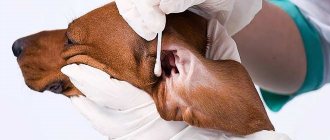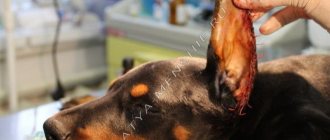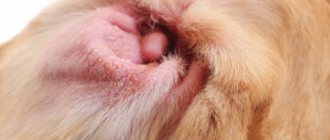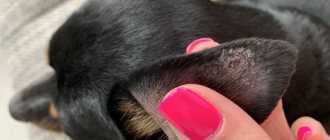Even an inexperienced owner, when faced with the appearance of discharge from a pet’s ears, understands that such a condition cannot be called the norm. Especially if it is accompanied by painful sensations, itching, attempts to shake the head and an unpleasant odor.
Liquid or purulent discharge of various colors from the auricle is one of the most obvious signs of otitis media, or inflammation of the ear canal. At the same time, the onset of the disease can be triggered by many reasons, and the consequences can be very tragic. That is why, at the first signs of poor health, it is necessary to urgently take the dog to the veterinarian in order to avoid the development of negative consequences, which are not always possible to get rid of.
Causes
Otitis media is more of a symptom than an independent disease . It manifests itself as a reaction to many reasons. Moreover, depending on the root cause, the discharge has a different smell, consistency and color and is accompanied by various additional signs.
The most common culprits of the disease:
- Hypothermia . This problem most often occurs in pampered domestic dogs or representatives of short-haired breeds. Moreover, not only winter cold or rainy, dank autumn weather can provoke the onset of inflammation, but also air conditioning or a draft on a hot summer day. If inflammation occurs, fluid does not begin to be released immediately, but only 2-3 days after other signs appear. It will not have an unpleasant odor or color.
- Infection with a microparasite - mite . In this case, a whole list of additional symptoms appears, including constant itching, leading to nervousness of the dog and constant shaking of the head and scratching the outside. Both ear canals or just one may be affected. It is not liquid that is released, but rather a viscous brown liquid with a sharply unpleasant odor. An accurate identification of the parasite and the prescription of drugs for treatment is only possible when contacting a veterinarian.
- Water getting into the ear canal . This problem is especially relevant for those with large floppy ears, but other dogs are not protected from it, it’s just that a large floppy ear creates special conditions for the faster development of pathogenic microflora that provokes the development of otitis media. It will come along with pain, deafness and other unpleasant sensations. Depending on the stage of the process, the discharge can be almost odorless and transparent, or white or yellow and stinking.
- Fungus or proliferation of staphylococcus , appearing against the background of weakened immunity or death of the natural microflora that protects the body from such parasites. Often occurs with immunodeficiency or long-term use of antibiotics. The flow of liquid will not be profuse, but will have a very bad smell and will be whitish or brown in color.
- Infectious infection caused by trauma. In this case, the dog himself is often to blame, causing small scratches to himself when trying to scratch himself, and then introducing an infection into the open wound. In this case, poor health is accompanied by visible problems. The ear swells and turns red, and begins to ooze pus.
Only a veterinarian can accurately determine the cause of otitis media, but your observation will greatly help him. Accurate information about events in the dog's life over the previous few days can significantly narrow down the range of possible diagnosable causes.
encyclopedia of life answers
larisa
A dog's ear is a very sensitive and delicate organ, so if you notice suspicious discharge, be sure to contact your veterinarian!
If you find an error, please select a piece of text and press Ctrl+Enter.
We have a gorgeous German Shepherd named Dean at home. We love this cheerful and intelligent dog very much, we carefully monitor his health, try to feed him properly and take him for walks a lot. Unfortunately, even the most beloved and well-groomed dogs have health problems. This fate did not escape us either. But now I have some experience in treating otitis media, which I would like to share with you.
Where it all started
So, like I said, we walk a lot. 2-3 times a day for 1.5 hours, fortunately I have plenty of free time. When we come back from a walk, I always check Dean for fleas and ticks (okay, now you won't see them anymore, but still) and always wipe his paws. We have a real ritual!
Once again, when Dean and I returned from a walk, I noticed that he began to behave somehow strangely: shaking his head and scratching his ears with his paws. At first I thought it was him who was playing like that, since he is still a playful person. However, some obsessiveness appeared in the movements, and I suspected something was wrong.
I decided to see what could be bothering the dog. When I looked into the ear, I was horrified - the dog was leaking wax from the ear, and quite a large amount. The discharge resembled plasticine and was brown in color. I tried to wipe off the pus, but the dog was in pain. Oddly enough, I never even thought about going to a veterinarian. Instead, the next morning I called my friends to find out if their pets had had this and what to do in such cases. Having listened to enough advice, I went to a veterinary pharmacy and bought medicine.
Ear medications for dogs
- drops "BARS";
- "Fungin - spray";
- Otinum drops.
Armed with this arsenal, I began treatment. No matter what I tried: I dripped, and wiped, and sprayed with spray, but the dog only got worse. The dog scratched his already torn ear even more.
Otitis - how to recognize?
Ultimately, I just couldn’t stand it anymore and went to the vet. This was the last and only person who could explain everything to me clearly and clearly. As it turned out, 20% of dogs suffer from ear diseases. There is nothing fatal in this, but you can’t start the disease either. It is in the fall that otitis media becomes especially relevant.
Types of otitis
- allergic;
- tick-borne;
- catarrhal.
The doctor told me that my dog is developing a disease of the middle and outer ear.
Symptoms of otitis media
- hot ear;
- redness or swelling of the ear;
- discharge, purulent or clear;
- deterioration of the dog’s condition (with purulent otitis media), lethargy, lack of appetite;
- the dog shakes its head;
- tilts his head where it hurts;
- constantly scratches his ear.
Causative agents of otitis
- bacteria (Proteus, staphylococci, streptococci, etc.);
- simple fungi.
Pathogens can be pathogenic, that is, under certain circumstances they will cause various kinds of diseases, not excluding otitis media. Such circumstances may include:
- hypothermia;
- decreased immunity;
- improper feeding.
Another pathogen is ear mites. You can get this friend anywhere, but as the doctor explained, ear mites are most often transmitted through contact with dogs or cats sick with otodectosis.
Treatment of otitis media in dogs
So, if your dog's ears are running, what remedies can you use? As they answered me, the average form of otitis should be dealt with by a doctor. Only a correct diagnosis by a doctor with identification of the pathogen can help the dog’s recovery.
Usually, with an advanced form of otitis, the doctor must take a smear of sulfur and send it for microscopic examination. But our form is not so advanced, so we got off quite lightly.
But I learned that otitis media can be easily confused with otodectosis. And if the initial form of the disease is started without consulting a doctor and self-medicating, perforation (rupture) of the eardrum may occur.
However, it often happens that there is no veterinarian nearby. Do not despair, because there are drugs whose use is allowed in this case:
- "Sofradex";
- "Ottipax";
- "Ottinum."
These drops relieve itching, pain and do not cause harm. If your dog's ear is scratched until it bleeds, you should treat it with brilliant green or hydrogen peroxide, carefully applying the product to the crusts that have formed over the wounds.
Treatment regimen
- Clean the auricle of wax and drop drops of “Otiiovin” there, 3 to 5 drops into each ear, the course of treatment is 7 days. Drop five times a day, after which day reduce the dose by two drops;
- Gamavit injections. Inject into the withers for 5-7 days, 2-3 ml;
- Antibiotic intramuscularly, for example, baytril, cefazolin;
- Keep the dog warm and wipe the ears with a soft cloth.
For prevention, you should regularly clean your dog's ears with cotton swabs to remove excess wax. I hope my tips were helpful to you. I hope for interesting recommendations from you.
Dangerous symptoms
Otitis itself is already dangerous in that gradually the inflammation can go further. It can damage the inner ear, permanently deprive one of hearing, or even spread to the brain, but the reasons that provoked it are also important. You can determine exactly how bad the animal’s situation is only by analyzing all the symptoms.
The most dangerous are considered:
- Unpleasant odor coming from the ears.
- Constant urge to scratch the affected area.
- The dog constantly shakes his head.
- Increased body temperature.
- Loss of coordination.
- Walking in circles.
- Epileptic seizures.
- Gradual loss of vision.
- Lack of response to the owner's voice or other loud sounds.
- Standing still.
- Permanent “facing the wall” position
If you consult a doctor promptly when you first notice fluid leaking from your ears, you can avoid further development of the disease and have time to treat it before the consequences become irreversible.
Signs of a disease in a dog
An unpleasant smell from a dog's ears is usually accompanied by other symptoms. The animal constantly scratches its head, shakes its ears, sometimes scratching its ears until they bleed. Fluid, ichor, and wax may be released from the ear canals, and irritation and redness may appear around the ears. The dog walks with its head tilted towards the source of inflammation. In the case of external otitis, disorientation in space may be observed. Even lightly touching the sore area causes her pain. The pet’s behavior also changes, it becomes apathetic or, conversely, aggressive.
Treatment options
It will not be possible to determine the animal’s condition through an external examination, since the dog experiences constant pain and can even bite the owner when attempting a detailed examination of the auricle, so it is worth leaving the diagnosis, identification of the root cause and selection of treatment to professionals.
If you notice an inflammation of the ear, do not try to treat it using the usual human methods, you will only harm the dog and aggravate his condition. Under no circumstances should you give human medications, heat the affected area, or pour any liquids into the ear canal.
The only thing that can be done is to add chamomile decoction to the water to slightly calm the dog’s nervous system.
The doctor will determine the root cause of the disease and prescribe a course of medications and procedures that are suitable in a particular case. In a particularly advanced situation, surgical intervention may be necessary.
General information about otitis media
A dog's ear consists of several parts:
- The external auricle , which serves as a locator and protection for the middle ear, where the main auditory organs (tympanic membrane, auditory tube, malleus and incus) are located. It is this link that is better developed in animals than in humans.
- The inner ear serves as a connection to the brain and conducts signals along nerve endings.
Otitis can appear in each of these sections, causing unpleasant symptoms. In addition, they can be caused by an infection, or cause an ear canal infection.
Causes of the disease
The causes may be related to both the environment and internal problems of the dog. Main prerequisites for the development of the disease:
- Drafts, strong winds and damp weather lead to hypothermia, colds and blowing ears, as a result - otitis media;
- Weak immunity (due to the inability to fight bacteria, the dog often gets sick and suffers relapses);
- Improper bathing, lack of drying (if water is regularly poured into the ears, and the animal is not dried and walks around wet, it is possible that otitis media will subsequently develop);
- Injuries, concussions, severe bruises;
- Allergies;
- Parasites (usually external: ticks, fleas, which destroy the integrity of the skin and membranes of blood vessels, spread poison and infection, cause irritation and itching);
- Reproduction of bacteria and viruses as a consequence of infectious infection (otitis may be a sign of proliferation of pyogenic cocci);
- Incorrect or irregular hygiene procedures;
- Getting foreign objects into the ear canals (from small children's toys to street dust and debris);
- Genetic predisposition of certain breeds;
- Hormonal imbalances (autoimmune or thyroid diseases);
- The presence of sugar in the diet (causes increased secretion of sulfur).
Varieties
Otitis is a complex disease that has various forms. First of all, there are two main types: primary and secondary. The first is considered independent, is very rare, and develops with frequent diving or walking in a draft. Secondary is caused by external negative factors - bacteria, insects and other irritants.
By anatomical location
The classification divides otitis media according to the location of the main inflammation. There is an external, middle and internal process. The first develops in the auricle and does not spread to the eardrum. Medium affects the main auditory organs and is considered the most common. Internal is the most dangerous; it can lead to infection of nerve endings and complications in the brain.
According to the irritant leading to the disease
There are subtypes that characterize otitis due to development. There are fungal, allergic, parasitic, bacterial and verrucous.
- Fungal otitis media appears due to pathogenic fungi and is called otomycosis. A characteristic feature is a clear manifestation of infection, covering the auricle and canals with a pimply crust. The fungus quickly mixes with wax and penetrates all parts of the ear. Without proper timely treatment, it can lead to serious and dangerous consequences.
- Bacterial is caused by the proliferation of bacteria for various reasons: weakened immunity, hypothermia, a disease that has not been treated. May cause hyperthermia and other symptoms of bacterial infection.
- Allergies cannot be treated using standard methods. First of all, the veterinarian determines the cause of the allergy. Anti-allergenic drugs are used. The disease causes severe itching, bumps, and irritation inside the ear.
- The verrucous type is caused by the proliferation of a wart inside the ear opening. Thus, growths and bumps block the ear canal.
- Parasitic otitis, as the name implies, is caused by external parasites: fleas, ticks, whipworms. Insects destroy the entire skin, inject poison, promote the growth of bacteria, and irritate the skin.
By the nature of the discharge
There are types of otitis media based on the substances they secrete. The most common is purulent . A characteristic feature is purulent, foul-smelling discharge from the middle or inner ear. The second type is exudative . In this case, the volume of sulfur in which bacteria multiply increases.
According to the nature of the disease
The intensity of symptoms and the speed of development divides otitis media into chronic and acute . In the first case, all signs are blurry, dim, and the flow is slow; this type is difficult to identify and difficult to treat, and is often associated with allergies. Acute otitis is manifested by sharp unpleasant symptoms: high fever, itching, pain, large volume of discharge. It is easier to detect, and therefore easier to cure.
Other types of otitis
In addition to the above types, traumatic otitis and seasonal otitis .
- The first type can be caused by a severe injury, falling from a high object, or foreign objects entering the ear canals.
- Seasonal otitis is associated with weather changes. Directly correlated with colds due to drafts and dampness. One of the main preventive measures is protecting your pet from the cold.
Main symptoms
Symptoms of otitis media are similar for all types, regardless of the cause. Of course, there are characteristic differences, but, one way or another, the main features are the same:
- Inflammation, redness of the auricle or ear canal;
- Uncharacteristic growths, bumps, scabs and crusts inside the ear;
- Unpleasant odor, increased volume of mucus and sulfur secreted;
- Increased body temperature;
- The pet is restless: it scratches, presses its ear, whines;
- Lack of appetite with severe thirst;
- You may notice that the animal tilts its head towards the sore ear or shakes it;
- Hearing impairment, the dog does not respond to names or commands;
- There may be severe strabismus (with deep damage);
- Any touch will be painful for the pet.
Prevention
All breeds of dogs with large floppy ears are considered a risk group for diseases developing in the auricle, however, all other dogs are not protected from tick infection, otitis media and other dangerous diseases.
To keep your pet healthy for many years, you need to pay special attention to the protection and hygiene of the ears:
- Be sure to clean the inside of any dirt at least once every two weeks. To do this, it is enough to wipe the surface with a cotton swab dipped in a special liquid, removing all accumulated dirt, but there is no need to push the swab into the ear canal, as you can damage the organ.
- When bathing or swimming in open water, make sure that the inner surface of the ear remains dry, and if water gets in, remove it from there as quickly as possible.
- Correctly prepare a diet, taking into account all the needs of the animal. Eliminate foods that can cause allergies in a timely manner.
Damage to the hearing organs is a problem that is better avoided through prevention than treated with medication, since one of the most common consequences of inflammation of this part of the body is subsequent deafness.
Diagnostics
- Complete medical history. Taking an anamnesis is important to determine the underlying disease that is causing the ear drainage problem. Expect your veterinarian to ask you about when the symptoms began, whether your pet has had ear problems before, and whether there are other symptoms of skin conditions.
- Full medical examination. Your veterinarian will perform a physical examination of your dog, including a thorough examination of all skin and an examination of the ear using an otoscope. It is important for your veterinarian to ensure that the eardrum is intact and healthy to determine whether the problem is in the outer ear or whether the middle ear is also affected. An otoscopic examination also allows the veterinarian to look for foreign bodies or mites in the ear and evaluate changes in the condition of the ear canal due to chronic disease.
- Cytological test. Typically, a swab is taken from the ear and rolled onto a microscope slide to be stained for examination under a microscope (cytology). The slide is examined for the presence of yeast or bacteria and inflammatory cells. Undyed swabs can be rolled out in mineral oil to test for ear mites.
- Culture to determine the type of bacteria present.
- For chronic or recurring ear problems, other diagnostic tests may be needed to determine the underlying cause of your symptoms. Bacteria or yeast infections are never the main cause of ear disease, but rather make symptoms worse. Testing may be done for allergies, hypothyroidism, autoimmune disease, or other underlying causes.











